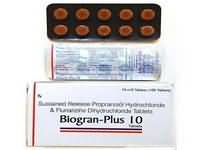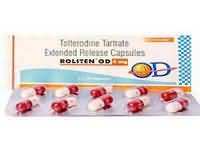propranolol hydrochloride

CLINICAL USE
Beta-adrenoceptor blocker:Hypertension Phaeochromocytoma Angina Arrhythmias Anxiety Migraine prophylaxis
DOSE IN NORMAL RENAL FUNCTION
Hypertension: 40–160 mg twice daily Phaeochromocytoma: 60 mg daily for 3 days before surgery, or 30 mg daily if unsuitable for surgeryAngina: 120–240 mg daily in divided doses Arrhythmias: 10–40 mg 3–4 times daily Anxiety: 40 mg 1–3 times daily Prophylaxis after an MI: 40 mg 4 times daily then 80 mg twice dailyMigraine and essential tremor: 80–160 mg dailyIV: 1 mg over 1 minute repeated after 2 minutes to a maximum of 10 mg (5 mg with anaesthesia)
PHARMACOKINETICS
Molecular weight :295.8 %Protein binding :80–95 %Excreted unchanged in urine : <5 Volume of distribution (L/kg) :4half-life – normal/ESRD (hrs) :2–6/Unchanged DOSE IN RENAL IMPAIRMENT
GFR (mL/MIN)
20 to 50 : Dose as in normal renal function 10 to 20 : Start with small doses and increase according to response <10 : Start with small doses and increase according to response DOSE IN PATIENTS UNDERGOING RENAL REPLACEMENT THERAPIES
CAPD :Not dialysed. Dose as in GFR <10 mL/min HD :Not dialysed. Dose as in GFR <10 mL/min HDF/high flux :Unknown dialysability. Dose as in GFR <10 mL/minCAV/VVHD :Unknown dialysability. Dose as in GFR 10 to 20 mL/min IMPORTANT DRUG INTERACTIONS
Potentially hazardous interactions with other drugs Anaesthetics: enhanced hypotensive effect; risk of bupivacaine toxicity increasedAnalgesics: NSAIDs antagonise hypotensive effectAnti-arrhythmics: increased risk of myocardial depression and bradycardia; increased risk of bradycardia, myocardial depression and AV block with amiodarone; concentration increased by propafenoneAntibacterials: metabolism increased by rifampicinAntidepressants: enhanced hypotensive effect with MAOIs; concentration increased by fluvoxamine; concentration of imipramine increasedAntihypertensives; enhanced hypotensive effect; increased risk of withdrawal hypertension with clonidine; increased risk of first dose hypotensive effect with post-synaptic alpha-blockers such as prazosinAntimalarials: increased risk of bradycardia with mefloquineAntipsychotics enhanced hypotensive effect with phenothiazines; concentration of both drugs increased with chlorpromazine Calcium-channel blockers: increased risk of bradycardia and AV block with diltiazem; hypotension and heart failure possible with nifedipine and nisoldipine; asystole, severe hypotension and heart failure with verapamil Diuretics: enhanced hypotensive effect Moxisylyte: possible severe postural hypotensionPropranolol hydrochloride.618 PROPRANOLOL HYDROCHLORIDeSympathomimetics: severe hypertension with adrenaline and noradrenaline and possibly with dobutamineTropisetron: increased risk of ventricular arrhythmias – use with caution ADMINISTRATION
Reconstition
– Route
Oral, IV Rate of Administration
–Comments
– OTHER INFORMATION
Non-selective active metabolites accumulate in renal impairment. Consider metoprolol or atenololMay reduce renal blood flow in severe renal impairment.
See how to identify renal failure stages according to GFR calculation
See how to diagnose irreversible renal disease
Home









